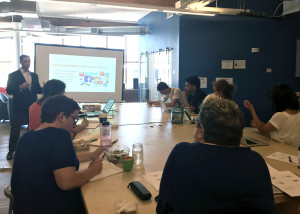SEG hosted Pete Lucas, vice president of business development at JH Communications, in a class about telling our brand story. We talked about different types of social media, what goes into decision-making and avoiding some common pitfalls. Here are 5 things I learned:
- Hey, what IS my brand story? Perhaps we can’t create and tell a story about our brand if we don’t know what our brand is, right? So first we must do the work of figuring this out. How to go about it will vary depending on what type of business we are running, the size and location, but often with a social enterprise this will mean telling the story of our mission. We will tell the story of our values, what we offer and how we got here. We can do this work ourselves, or with our co-workers, or we can enlist professional help. One way to do this, Lucas suggests, is to use visuals and to “show pictures of ourselves doing our jobs.”
- Social media is collaborative. You like mine and I’ll like yours, and together we will get twice the exposure as alone. Tagging people on social media has a purpose. “Leverage your friends” says Lucas, and sharing their posts and events is one way to do so. You might consider setting guidelines on this sharing, for example being sure that those friends share your values, behave ethically and enhance the overall brand narrative. For example, an organization whose mission is lung health may not want to share posts sponsored by Philip Morris. And be sure to thank others and let them know you appreciate the support!
- Use your budget wisely. There are many ways to spend money on social media, from boosting posts to buying likes. Lucas suggests that we use analytics to help us determine what works best for our particular needs. For example, he notes that a business which serves a local audience will care about their followers’ zip codes, whereas a national brand might care more about the age of their customers, for example. He also suggests we track the results of a “call to action” in order to help determine the effectiveness of our campaign.
- Good visuals matter! Have you ever seen a photo taken of a subject squinting against the bright sun, or standing in front of a busy billboard? Perhaps a video of someone competing with a TV screen, talking heads or wild squirrel behavior playing out while you try to zoom in on the content? It’s known that humans are distractible, that some white space is soothing and that setting up the shot is worth the 5 minutes it takes. So make your visuals work before you share them. And, Lucas says, “not everyone is meant to talk on camera.” Perhaps a written piece or a sound bite is best for those who aren’t able to deliver several perfect minutes of un-edited tape.
Know your audience(s). The type of language which might fit right in with a young, liberal-minded audience looking for the hottest swimwear might shock the socks off of the group you’re advertising Metamucil to. So try to target the content to the audience. Of course, we can never know all who will see it, we can never predict how people will react, and it’s good to stay flexible on this. But the advice Lucas gave us is “Remember, this is not your personal page.” Think of your audience before over-sharing, and only do so if it is an integral part of your brand.
Traci Picard
Venture Development Assistant
Traci Picard is a VISTA serving as Venture Development assistant here at SEG. She comes from the world of alternative health, running a small herbal business and teaching classes like Critical Thinking for Herbalists and Asking Better Questions. Traci is also a writer pursuing a Journalism degree, a mother of 3 and a passionate fan of books and the Public Library. Born in Providence, she has lived all over but continues to return home.
Contact: tpicard@segreenhouse.org


